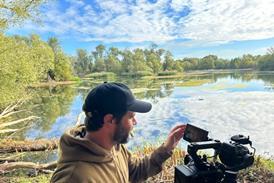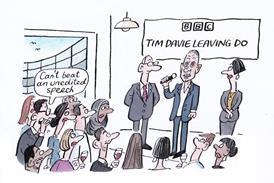Broadcasters have come together under the Digital Production Partnership to address the challenges faced by producers in the shift to tapeless. Broadcast looks at some of the findings of their latest report
The shift away from tape poses some tricky questions for production companies. Most will have been acquiring the bulk of their content with tapeless cameras for a few years now, but having to deal with files rather than tape can appear awkward and costly.
In response to the challenges production companies face as tape makes way for file, the Digital Production Partnership (DPP), a BBC, ITV and Channel 4-led cross-broadcaster group, has been formed.
The DPP’s first attempt to help the production community was the March publication of common standards for the tape-based delivery of HD and SD material. Next on the agenda is a technical specification for programmes delivered as files, and in the build-up to its publication (see box), the DPP has commissioned media technology consultant Mediasmiths to compile a report on digital production.
ITV director of broadcast services and DPP chair Helen Stevens says there is “confusion, a lack of clarity and mystery” around file-based workflows. “We have got a big learning curve ahead of us and broadcasters need to help the industry,” she says.
The report, The Reluctant Revolution: Breaking Down the Barriers to Digital Production in Television, describes the move to end-to-end digital production as “inevitable”, but says the pace of change is “limited by the lack of clear signposts and reluctance in the production community to set off on the journey”. This “reluctance” is the result of a failure on the part of broadcasters, suppliers and manufacturers to understand the practical realities and frustrations of the production community.
Obstacles to take-up
For producers, the main obstacles to a fully tapeless workflow are technology, cost and operating practices, with “safe, cheap, simple storage and retrieval of file-based video assets” considered the single greatest need of any producer going tapeless.
BBC North controller of production, and the BBC’s DPP lead, Mark Harrison says that “pretty much everyone” is acquiring content tapelessly because that is the way camera technology has developed.
“It immediately gives you an insight into what is going on; the community has adopted a technology because it didn’t have a choice,” he says. “That is very different from recognising the benefits and acting.”
Production firms spend significant sums sending tape-based content to broadcasters by courier, but it is a cost that could be put towards high bandwidth networks, which could in turn be used to deliver file-based programmes. Where project-based budgeting is the norm for productions, the report found “no sign at the moment that any network provider will offer anything other than fixed-term contracts and relatively high set-up fees”.
An ‘always on’ model is unlikely to be appealing to production firms, which would only need access to a strong connection when they upload or deliver material. The issue of internet connectivity illustrates a wider problem: the lack of a production-focused business model. And it affects another vital aspect of digital workflow: metadata.
“Once you move to a file-based workfl ow, you need better quality metadata to fi nd things,” says Mediasmiths managing director Niall Duffy.
“With a tape, you can always slot it in a machine or it is likely to be labelled. But if you come across a file with a 16-character name, it can be hard to find out what it is.” However, the large-scale tagging of content is an incremental cost rather than a different expression of an existing cost, Duffy explains, which poses problems for those wrestling with decreasing budgets.
Disconnected industry
Harrison says there is a lack of connection between producers, broadcasters, suppliers and technologists. “It’s time to call it out and acknowledge it, and for broadcasters, technologists and suppliers to take an active responsibility in assisting the production community,” he says.
The worlds of IT and production could be brought together by a facility that helps to “aggregate the spiky, unpredictable needs” of smaller and medium-sized indies by providing scale from IT providers.
“I think there will be an evolution of what we already have, rather than a whole new industry springing up,” says Stevens. “There is an opportunity for any kind of post-production company or supplier that has the right understanding and technology to offer services.”
Harrison adds:”There is an enormous opportunity here and I am a little surprised that more haven’t grabbed it more forcefully and sooner.” Duffy believes that if post companies don’t start offering more media management services, larger indies will do it themselves.
“I’m not sure where that will leave the smaller production companies, but my suspicion is they will not be in a good place. In a digital workflow, there is a danger of the haves and have-nots.”
By 2014, ITV, the BBC and C4 want a “total transformation” of the way they receive material, with file-based delivery the norm. “We are not planning to flick a switch and say ‘this is it’,” says Stevens. “We recognise that people have kit and it needs to be fully depreciated. But a lot of companies have already started the process.”
The challenge is to build on the momentum and continue that transformation through the production, post and playout process.
“Producers want to see content move smoothly through the content chain and build up archive for secondary use,” says Bal Samra, director, BBC rights and business affairs, director, Vision Operations, and DPP executive sponsor.
“Indies are prepared to make investments but they don’t want to get it wrong, and broadcasters all want something different and keep changing their minds. For production companies to make progress, they need coherence from broadcasters - that is what the DPP is trying to achieve.”
The full report is available here
A single standard
The DPP is working with US-based Advanced Media Workflow Association (AMWA) on a new standard for HD files.
AMWA will publish ‘AS-11’ by the end of the year, with the DPP’s subset of the file structure to follow.
Common metadata standards, which form a key part of the new delivery guidelines, have been developed with reference to the European Broadcasting Union’s ‘EBU Core’.
Once published, UK Screen members will be consulted regarding the tech spec.
Channel 4 chief technology officer, and the broadcaster’s DPP lead, Kevin Burrows says the new file format will result in a higher quality master from which to transcode.
“It will mean we can support HD more easily, and that we can automate the transcode process.”
The BBC, ITV and C4 will begin to take delivery of programmes on file on a selective basis next year, with file-based delivery the preferred format by 2014.
Storage: comparing costs
Consultant Mediasmiths examined the cost of storage and found that if content is held for short periods of time, cloud storage is attractive compared with tape. But the costs accumulate over time, and over the course of a year, cloud-based storage is estimated to cost £1.19 per GB. In comparison, LTO (linear-tape-open) has an annual cost of about £0.12 per GB, although set-up costs are estimated to be between £2,000 and £15,000. Removable drives are estimated to cost £0.43 per GB over the course of a year. “A key conclusion is that cloud-based storage is only really applicable for ‘temporal’ storage needs, and where content needs to be accessed by multiple parties,” says Mediasmiths managing director Niall Duffy.


























No comments yet